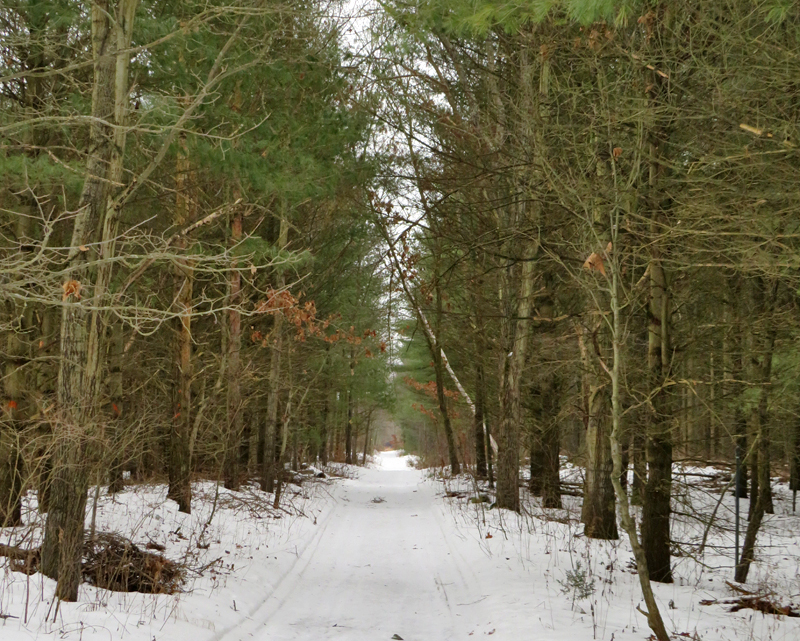By Sue Graci
At 25 per cent, Norfolk County boasts the highest percentage of forest cover of any county in Southwestern Ontario. If you think our forests are special, you’re right.
We live in one of only 11 Priority Places in Canada and the only one in Ontario. We are in the Long Point Biosphere Region, a United Nations Educational, Scientific and Cultural Organization site.
We have Carolinian species, such as eastern flowering dogwood, cucumber magnolia, pawpaw tree, black gum and tulip tree, which are at their northern limit. We’re home to a whopping 25 per cent of all species at risk in Canada, and our healthy, extensive forests are critical in maintaining them.
Who owns these forests and how are they managed? Are they in good shape? What does the future of these forests look like?
These questions have complicated answers.
Norfolk County forests offer habitat for wildlife, economic benefits when harvested responsibly, recreational opportunities, and the obvious health benefits of having oxygen-producing, carbon-storing organisms throughout the area.
But you may not know that Norfolk County was in danger of blowing away because of a lack of trees in the late 19th and early 20th centuries. The vast forests that had once made settling here so desirable had been cut down until there were no roots to hold down our famous sandy soil. Settlers were forced to remove forests on their land or face penalties. It is hard to imagine driving to Turkey Point and seeing barren land, blow outs and sand dunes but in the early 1900s, that is exactly what it was like.
The St. Williams Forestry Station was established in 1908 as Ontario’s first reforestation project. By planting species such as pine, oak, cedar, and poplar, the goal was to turn the barren lands back to their original forested cover.
The station served Norfolk County and Ontario, shipping free seedlings to anyone who asked. Hectare by hectare, trees replaced sand dunes, and their roots once again held the sandy soil in place.
Over two billion trees have been raised at the former forestry station, which is now St. Williams Conservation Reserve.
Today, a mere century later, Norfolk has one of the highest rates of forest cover in the area. But it takes planning and hard work to maintain these forests.
Along local roads, one sees signs for Norfolk County Forests, Long Point Region Conservation Authority, Long Point Basin Land Trust, St. Williams Conservation Reserve, Turkey Point Provincial Park, Norfolk Woodlot Owners Association, and more, not to mention all the privately owned forested lands.
So, who are these organizations managing the forests and what do they do?
First, one should know that timber operations are of major economic importance to Norfolk, and there are strict bylaws that govern them. According to the county’s website, “Forest conservation by-laws allow a municipality to encourage good forestry practices, reduce negative impacts on woodlands caused by tree removal activities, and regulate the loss of forest cover from the landscape.”
Adam Biddle, supervisor of forestry for Norfolk County, told the Maple Leaf about the municipality’s forests.
“Norfolk County owns and manages approximately 2,480 acres of forests in Norfolk County. This forested acreage is located across many different properties… and includes rural forested lots, [as well as] forests located in parks, on water treatment facility properties, [in] urban ravines, and [on] transfer station properties,” he said.
Adam added that the region’s forests “can be divided into three different categories based on land ownership: public land, private land, and private conservation land.”
Public land is “owned by a government entity,” private land is “owned by an individual or corporation that is not a government entity,” and private conservation land is “owned by a non-government entity, often a not-for-profit organization such as a land trust, where the primary objective of the organization includes the conservation of natural areas.”
It can be a challenge, he said, “Balancing the wants and needs of different users/general public, while also maintaining the ecological integrity of the forest.”
“County forests are accessible to the public, and everyone has their own idea of how the forest can [or] should be used. Establishing authorized and unauthorized uses for publicly owned forests can be contentious. Protection of sensitive species and habitat types adds another layer of complexity when trying to permit/promote the public use of a forested property.”
Norfolk has a 20-year forest management plan that extends through 2038, covering 35 different properties.
One aspect of forest management is becoming increasingly important: protection. Trees can be vulnerable to disease, pests, and competition from invasive species.
“Invasive species and invasive forest pests can be plants, animals, insects, or pathogens that are not from this area and pose a risk to the local environment. Invasive species can displace local native species and may have a detrimental effect [on] the health of native species. New invasive species are continually being introduced to the area, forcing forest managers to adapt to new threats all the time,” Adam said.
Forests do not exist in isolation, nor do the people responsible for their management. Adam said county staff “often interact with other local forest managers.”
“Although not through any formal process, these interactions often occur as a result of staff participating in the same workshops, training, or public events as other local forest managers. Where different organizations are undertaking of similar management activities, it is not uncommon for staff and other forest managers to consult with one another.”
Joelle Giles, project co-ordinator for the 2,552-acre St. Williams Conservation Reserve, said, “Our natural heritage goal involves reverting pine plantations back to pre-settlement conditions, including oak savanna, oak woodland, tallgrass and sand barren habitats.”
Reflecting on the reserve’s forestry farm roots, Joelle said, “100 years ago, pine plantations seemed to be the best way to manage the land, and now we’re undoing those efforts because of what we have learned. Maybe in the next 100 years we will be managing forests in a way that is unthinkable today because of new information.”
Pine plantations prevent sunlight from reaching the ground, which impacts the plants that can survive there. Often there is a thick layer of dead pine needles and little else. A return to native forest composition will bring back understory plants that thrive in the sunlight that filters through a mix of coniferous trees such as native pines and spruce, and hardwoods such as oak and maple.
Animals will return when the plants they require for food and habitat can be found.
Joelle told us she is surprised by “how much work there is to do” in managing forests.
“You would think that nature will look after itself, but without the care, planning, and time of dedicated individuals, it is clear that, if left unchecked, garden waste dumping, garbage dumping, and invasive plant and insect invasion would eventually smother out the incredible biodiversity that currently exists.”
When asked what she would like Norfolk County residents to know about our forests, she said, “I can only emphasize the old adage ‘see the forest for the trees.’ There is so much hidden in a forest once you start looking, and the learning never stops… Don’t let the concern of ticks or biting insects keep you from experiencing the peace, the beauty, and the wonder that can be found in an outdoor space.”
Close to the St. Williams Conservation Reserve is Turkey Point Provincial Park. Park superintendent Jeff Pickersgill, who also oversees Long Point Provincial Park, said, “The purpose of the [Provincial Parks and Conservation Reserves Act] is to permanently protect a system of provincial parks and conservation reserves.”
He too is concerned with invasive species and the destruction they can bring, saying, “The management and control of invasive species is one of the biggest challenges we face. Control is necessary to reduce or prevent impacts to native species, biodiversity, ecosystem function and recreational opportunities.”
But there is hope.
“Nature can be resilient,” he said. “If you do some homework and find how to put the right management effort into specific areas, you will be surprised at how quickly a variety of natural species and functions return to that site.”
A success story, he said, is “plantation thinning to support biodiversity and prescribed burning,” which helps “to promote oak savanna habitat establishment and restoration.”
“Oak savanna is a rare and fragile ecosystem with open forest canopies dominated by oak, shrubs, tallgrass prairie and wildflower species.”
Mr. Pickersgill added, “It’s important to appreciate the balance required in order to protect the forest, while enjoying ecologically sustainable recreation opportunities. The amazing diversity, ecological significance and recreational values of Norfolk County forests are exemplary on a national scale.”
Long Point Basin Land Trust
The Long Point Basin Land Trust’s (LPBLT) website states its mission is “to protect the rich biodiversity and habitats of the Long Point Basin area,” and it focuses “its efforts on the Long Point Basin area and works with landowners and the local community to provide a helping hand to wild species and ecosystems in one of Ontario’s most naturally diverse regions.” The organization creates conservation corridors that allow the safe passage of wildlife through our area.
With over 1,201 acres, the land trust’s “properties reflect a wide range of habitats from forested swamps to upland deciduous forests as well as conifer plantations. Some forest is quite dense whereas in dry sandy areas the land trust is managing for low density black oak savanna, which is rare on the landscape,” said Ian Fife, land stewardship manager of the LPBLT.
When asked for a success story, Mr. Fife’s answer was a telling one. The phrase “it takes a village” truly applies to Norfolk County forests!
“It’s hard to share a success story that considers Norfolk County without considering the partners that work so closely together to protect Norfolk County forests. I think one of the best stories I can share from the LPBLT perspective is the purchase of our property, Fred Jonckheere Fishers Creek Nature Reserve.
“The purchase of this 45-hectare property contributed to protecting a greater forested area that is about 1,400 hectares in size and completed a wildlife corridor that is over 10 kilometres long of protected forest. Partners in this conserved area include Long Point Region Conservation Authority, Hamilton Naturalists Club, [LPBLT], and provincial lands.”
Norfolk Woodlot Owners
The Norfolk Woodlot Owners Association (NWOA) assists its members not only in best practices for timber harvesting, but with the “creation and preservation of wildlife habitat, preservation of rare, threatened and endangered species.” The organization’s members “promote the wise use and stewardship of Norfolk’s woodlots.”
John De Witt, president of the NWOA, said his group co-operates with such organizations as Long Point Region Conservation Authority, Nature Conservancy Canada, and the LPBLT, to name a few. The association’s approximately 300 members own around 6,100 acres in Norfolk County.
Mr. De Witt said, “NWOA conducted a member survey in 2013 and discovered that most members were more interested in establishing wildlife habitat than selling timber (though habitat creation and selling timber are not mutually exclusive).”
The association exists to advise and support its members, he said.
“[We] provide members with technical advice on all aspects of forest management from planting to harvesting, including but not limited to timber and fuel wood production, creation and preservation of wildlife habitat, preservation of rare, threatened and endangered species, and the production of other products such as ginseng, maple syrup and shiitake mushrooms.”
He would like more people to know about the NWOA and to realize that good woodlot management does not mean cutting down all the trees on a property. The group’s members “support the wise use and stewardship of Norfolk’s woodlots.”
Long Point Region Conservation Authority
Jessica King of Long Point Region Conservation Authority (LPRCA) said her organization also faces the challenge of managing invasive species.
“LPRCA has been affected by invasive species such as spongy moth, emerald ash borer and beech bark disease/beech leaf disease, which have caused great devastation to certain tree species.
Japanese knotweed, phragmites and garlic mustard, amongst many others, also threaten the forest tracts,” she said.
LPRCA has “approximately 10,000 acres of forest tracts in which 1,145 acres have been designated as Natural Heritage Woodlands.”
“The [LPRCA Forest Management Plan] sets out an overarching framework for actively managing all Authority lands with sustainable forestry practices that aim to protect and enhance biodiversity and wildlife habitat.”
This is another organization that works alongside groups with similar goals. Ms. King said, “LPRCA is part of a community group called the Forest and Treed working group alongside the [LPBLT], St. Williams Conservation Reserve and Norfolk County to manage and improve upland habitat in Ontario’s Priority Place Long Point Walsingham Forest.”
Regardless of the organization, the common theme is conservation and preservation, even when timber is harvested. There is no advocacy for clear cutting without reforestation because forest health is critical in woodlot management. In growing trees for future harvest, natural habitat is preserved. This benefits everyone.
Major challenges include invasive species, increasing pressure on land for recreational use, and climate change.
It is reassuring to know that so many people across so many organizations are working towards the same goal—healthy forests that support diverse, sustainable ecosystems for future generations to enjoy.
—
Originally published in two parts on April 23 and April 30, 2025



